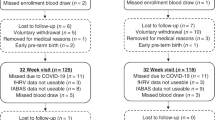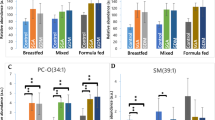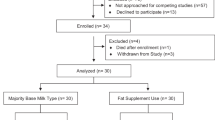Abstract
Objectives: To determine the effect of increasing docosahexaenoic acid (DHA, 22: 6 n-3) in breast milk on infant fatty acid profiles. A secondary aim was to examine aspects of neural development. Design and Setting Double blind, placebo controlled study of infants recruited from postnatal wards at Flinders Medical Centre. Subjects: Fifty-two healthy term infants who were breast fed for at least 12 weeks and were from middle class families. Intervention: Breast milk with DHA concentrations that ranged from 0.1–1.7% of total fatty acids. This was achieved by supplementation of the maternal diet for the first 12 weeks post partum. Results: Breast milk DHA was related to infant plasma (r=0.89, P<0.001) and erythrocyte (r=0.88, P<0.001) phospholipids in a saturable curvilinear manner so that breast milk DHA above 0.8% of total fatty acids resulted in little further increase in infant plasma or erythrocyte DHA levels. The rise in plasma and erythrocyte DHA was approximated by a fall in total n-6 polyunsaturated fatty acids. We could detect no relationship between visual evoked potential acuity (measured at 12 and 16 weeks) of infants by either the dietary grouping or the DHA status of individuals. A stepwise multiple regression showed that infant erythrocyte DHA at 12 weeks and home stimulation were the only independent factors associated with Bayley's MDI at 1 y (adjusted model r2=0.18, P<0.005); while at 2 y gender and social score of the spouse were the only significant predictors of Bayley's MDI (adjusted model r2=0.22, P<0.005). Conclusions: Increasing breast milk DHA levels caused a dose dependent saturable increase in infant plasma and erythrocyte phospholipid DHA. There were no long-term effects of infant DHA status on indices of neurodevelopment. Sponsorship: Financial support was provided by Martek Biosciences, MD, USA and the National Health and Medical Research Council, Australia.
This is a preview of subscription content, access via your institution
Access options
Subscribe to this journal
Receive 12 print issues and online access
$259.00 per year
only $21.58 per issue
Buy this article
- Purchase on Springer Link
- Instant access to full article PDF
Prices may be subject to local taxes which are calculated during checkout
Similar content being viewed by others
Author information
Authors and Affiliations
Rights and permissions
About this article
Cite this article
Gibson, R., Neumann, M. & Makrides, M. Effect of increasing breast milk docosahexaenoic acid on plasma and erythrocyte phospholipid fatty acids and neural indices of exclusively breast fed infants. Eur J Clin Nutr 51, 578–584 (1997). https://doi.org/10.1038/sj.ejcn.1600446
Received:
Revised:
Accepted:
Issue Date:
DOI: https://doi.org/10.1038/sj.ejcn.1600446
Keywords
This article is cited by
-
Fatty acid concentrations in preterm infants fed the exclusive human milk diet: a prospective cohort study
Journal of Perinatology (2023)
-
VEP estimation of visual acuity: a systematic review
Documenta Ophthalmologica (2021)
-
Impact of early-life diet on long-term renal health
Molecular and Cellular Pediatrics (2020)
-
Factors associated with plasma n-3 and n-6 polyunsaturated fatty acid levels in Tanzanian infants
European Journal of Clinical Nutrition (2020)
-
Fish intake reflects on DHA level in breast milk among lactating women in Latvia
International Breastfeeding Journal (2018)



